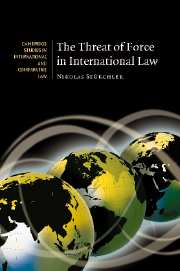Book contents
- Frontmatter
- Contents
- Foreword
- Preface
- List of abbreviations
- 1 Birth and infancy of a Charter rule: the open framework
- 2 The menu of choice: a guide to interpretation
- 3 Precedents of the international court of justice
- 4 Deciphering post-Charter practice: means and limits
- 5 Open threats to extract concessions
- 6 Demonstrations of force
- 7 Countervailing threats or: threats in self-defence
- 8 Findings and conclusions
- 9 Epilogue: the law in operation
- Annex
- Bibliography
- Index
- CAMBRIDGE STUDIES IN INTERNATIONAL AND COMPARATIVE LAW
Foreword
Published online by Cambridge University Press: 04 July 2009
- Frontmatter
- Contents
- Foreword
- Preface
- List of abbreviations
- 1 Birth and infancy of a Charter rule: the open framework
- 2 The menu of choice: a guide to interpretation
- 3 Precedents of the international court of justice
- 4 Deciphering post-Charter practice: means and limits
- 5 Open threats to extract concessions
- 6 Demonstrations of force
- 7 Countervailing threats or: threats in self-defence
- 8 Findings and conclusions
- 9 Epilogue: the law in operation
- Annex
- Bibliography
- Index
- CAMBRIDGE STUDIES IN INTERNATIONAL AND COMPARATIVE LAW
Summary
For a long time the subject of threats of force between states as a distinct field of study was surprisingly neglected both by international lawyers and, even, by international relations scholars. From the legal side Romana Sadurska's 1988 article, ‘Threats of Force’, is one of the few items devoted to the issue, and its argument that there is a significant legal difference between a use and a threat of force under article 2(4) of the United Nations Charter was not widely accepted. In the Nuclear Weapons Opinion (1996) the International Court of Justice glossed over any possible distinctions between use and threat – despite their importance for the theory and practice of deterrence.
In one sense this is not surprising. Article 2(4) itself appears to equate the two: all United Nations members ‘shall refrain in their international relations from the use or threat of force against the territorial integrity or political independence of a State’. On first impression a threat, sufficiently clear, imminent and credible, of a use of force which if carried out would be unlawful is itself unlawful. So international lawyers have tended to rest on the linkage between the two, without much further analysis – and to discount the point that responses to threats of force in state practice tend to be both rarer than and different in character to responses to the actual use of force.
- Type
- Chapter
- Information
- The Threat of Force in International Law , pp. xi - xiiPublisher: Cambridge University PressPrint publication year: 2007

